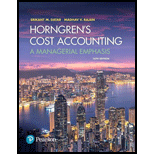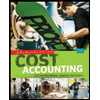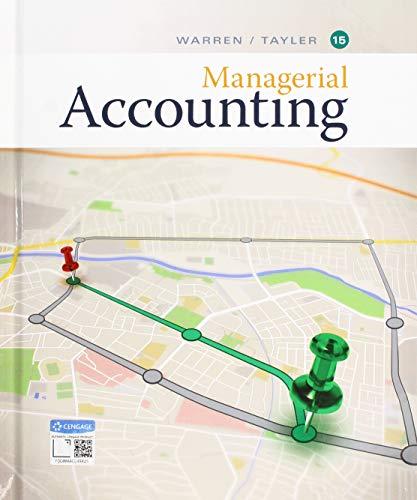
Horngren's Cost Accounting: A Managerial Emphasis (16th Edition)
16th Edition
ISBN: 9780134475585
Author: Srikant M. Datar, Madhav V. Rajan
Publisher: PEARSON
expand_more
expand_more
format_list_bulleted
Concept explainers
Textbook Question
Chapter 4, Problem 4.9Q
Distinguish between actual costing and normal costing.
Expert Solution & Answer
Want to see the full answer?
Check out a sample textbook solution
Chapter 4 Solutions
Horngren's Cost Accounting: A Managerial Emphasis (16th Edition)
Ch. 4 - Define cost pool, cost tracing, cost allocation,...Ch. 4 - How does a job-costing system differ from a...Ch. 4 - Why might an advertising agency use job costing...Ch. 4 - Describe the seven steps in job costing.Ch. 4 - Give examples of two cost objects in companies...Ch. 4 - Describe three major source documents used in...Ch. 4 - What is the advantage of using computerized source...Ch. 4 - Give two reasons why most organizations use an...Ch. 4 - Distinguish between actual costing and normal...Ch. 4 - Describe two ways in which a house-construction...
Ch. 4 - Comment on the following statement: In a...Ch. 4 - Describe three different debit entries to the...Ch. 4 - Describe three alternative ways to dispose of...Ch. 4 - When might a company use budgeted costs rather...Ch. 4 - Prob. 4.15QCh. 4 - Which of the following does not accurately...Ch. 4 - Sturdy Manufacturing Co. assembled the following...Ch. 4 - For which of the following industries would...Ch. 4 - ABC Company uses job-order costing and has...Ch. 4 - Under Stanford Corporations job costing system,...Ch. 4 - (10 min) Job costing, process costing. In each of...Ch. 4 - Actual costing, normal costing, accounting for...Ch. 4 - Job costing, normal and actual costing. Atkinson...Ch. 4 - Budgeted manufacturing overhead rate, allocated...Ch. 4 - Job costing, accounting for manufacturing...Ch. 4 - Job costing, consulting firm. Frontier Partners, a...Ch. 4 - Time period used to compute indirect cost rates....Ch. 4 - Accounting for manufacturing overhead. Creative...Ch. 4 - Job costing, journal entries. The University of...Ch. 4 - Journal entries, T-accounts, and source documents....Ch. 4 - Job costing, journal entries. Donald Transport...Ch. 4 - Job costing, unit cost, ending work in process....Ch. 4 - Job costing; actual, normal, and variation from...Ch. 4 - Job costing; variation on actual, normal, and...Ch. 4 - Proration of overhead. The Ride-On-Wave Company...Ch. 4 - Job costing, accounting for manufacturing...Ch. 4 - Service industry, job costing, law firm. Kidman ...Ch. 4 - Service industry, job costing, two direct- and two...Ch. 4 - Proration of overhead. (Z. Iqbal, adapted) The Zaf...Ch. 4 - Normal costing, overhead allocation, working...Ch. 4 - Proration of overhead with two indirect cost...Ch. 4 - General ledger relationships, under- and...Ch. 4 - Overview of general ledger relationships. Estevez...Ch. 4 - Allocation and proration of overhead. Resource...Ch. 4 - (2530 min.) Job costing, ethics. Joseph Underwood...Ch. 4 - Job costingservice industry. Market Pulse performs...
Knowledge Booster
Learn more about
Need a deep-dive on the concept behind this application? Look no further. Learn more about this topic, accounting and related others by exploring similar questions and additional content below.Similar questions
- What are the primary differences between traditional and activity-based costing?arrow_forwardWhat are the two main things that an activity-based costing system attempts to accomplish relative to direct and indirect costs?arrow_forwardWhat are the basic objectives in the use of standard costs?arrow_forward
- What is the primary difference between variable costing and absorption costing?arrow_forwardHow is the primary focus of activity-based costing different from that of traditional allocation?arrow_forwardWhen is an activity-based costing system better than a traditional allocation system?arrow_forward
arrow_back_ios
arrow_forward_ios
Recommended textbooks for you
- Principles of Accounting Volume 2AccountingISBN:9781947172609Author:OpenStaxPublisher:OpenStax College
 Principles of Cost AccountingAccountingISBN:9781305087408Author:Edward J. Vanderbeck, Maria R. MitchellPublisher:Cengage Learning
Principles of Cost AccountingAccountingISBN:9781305087408Author:Edward J. Vanderbeck, Maria R. MitchellPublisher:Cengage Learning Managerial AccountingAccountingISBN:9781337912020Author:Carl Warren, Ph.d. Cma William B. TaylerPublisher:South-Western College Pub
Managerial AccountingAccountingISBN:9781337912020Author:Carl Warren, Ph.d. Cma William B. TaylerPublisher:South-Western College Pub

Principles of Accounting Volume 2
Accounting
ISBN:9781947172609
Author:OpenStax
Publisher:OpenStax College

Principles of Cost Accounting
Accounting
ISBN:9781305087408
Author:Edward J. Vanderbeck, Maria R. Mitchell
Publisher:Cengage Learning

Managerial Accounting
Accounting
ISBN:9781337912020
Author:Carl Warren, Ph.d. Cma William B. Tayler
Publisher:South-Western College Pub
Cost Accounting - Definition, Purpose, Types, How it Works?; Author: WallStreetMojo;https://www.youtube.com/watch?v=AwrwUf8vYEY;License: Standard YouTube License, CC-BY